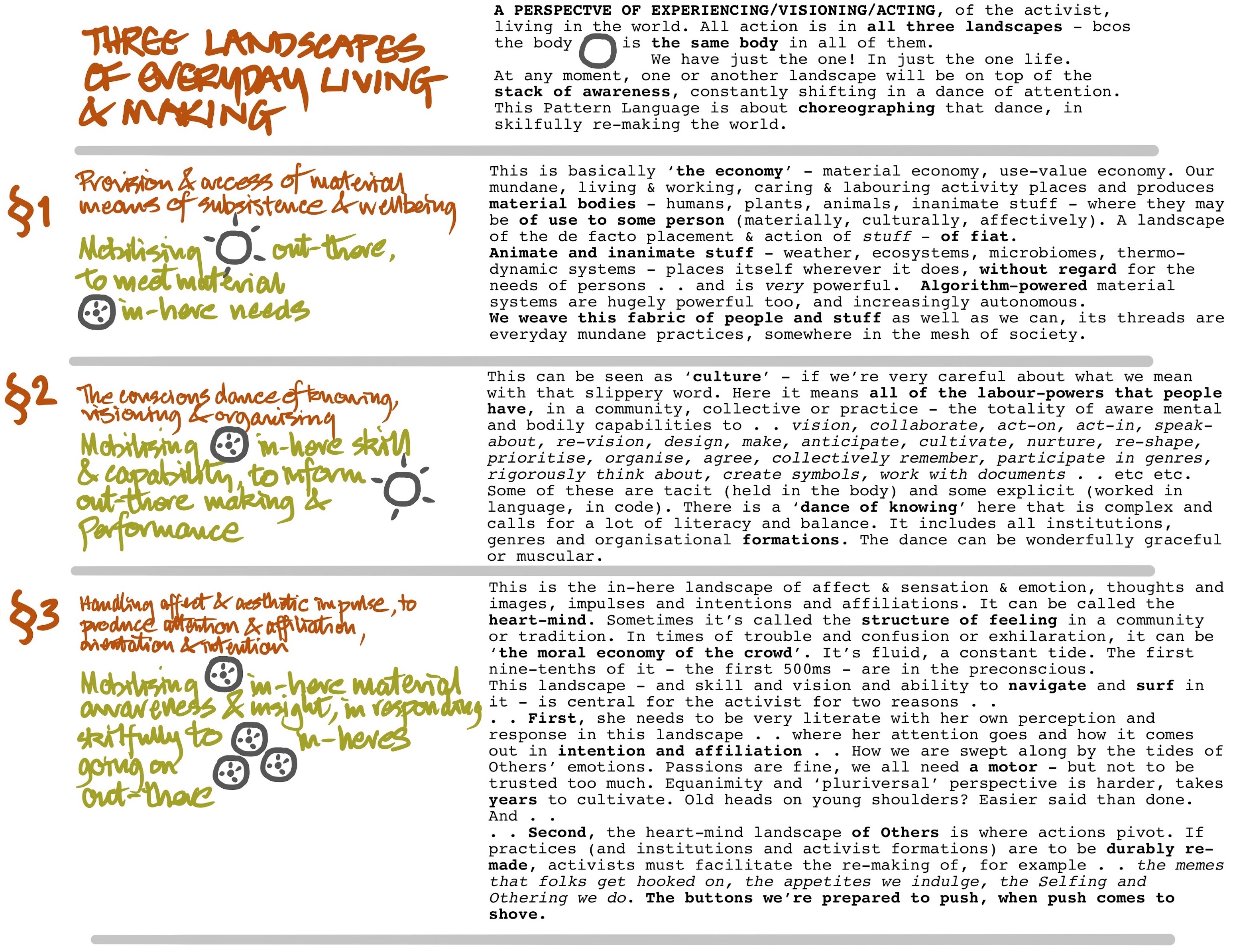Here we describe one of the two dimensions of the foprop frame: landscapes. 'Landscapes' are registers of consciousness and relationship; they organise our perception of the social-practical world.
The nature of the stuff that an activist may be engaging, handling and working with in the present moment is characterised via three 'landscapes of practice'. Each calls for a distinct kind of attention and capability.
This is a perspective of the experiencing/visoning/acting of the activist, living in the world. All action is in all three landscapes - bcos the body is the same body in all of them. We have just the one! In just the one life. At any moment, one or another landscape will be on top of the stack of awareness, constantly shifting in a dance of attention. The foprop pattern language is about choreographing that dance, in skilfully re-making and re-enacting the world.
# Distinct registers of consciousness and relationship Three landscapes of practice are identified, thus: - **Material landscape** - the materiality of means of subsistence and wellbeing, and objects in the world: not just food, housing, transportation, energy, etc etc, but also the material of our own bodies and others' bodies. This is a landscape of material **forms**. - **Cultural landscape** - the practical sphere of communicating and understanding, organising and collaborating, knowing and capably, intentionally doiung. This is a landscape of cultural **formations**. - **Aesthetic landscape** - the experiential stuff of feeling and intuiting, recognising and refusing to see, wanting something to be close and wanting something to stay far away (or maybe disappear totally). Etcetera. This is a landscape of aesthetic **forces**.
All three landscapes are always (and necessarily) present in practice, as experiential dimensions (sensation, thought, feeling). But we are not necessarily conscious of one or another. The materiality of the world may fall into the background when we are deep in thought or argument, and 'self' is in overdrive. The enormous force of preconscious processes in routinely (and necessarily) determining what we see and do can be lost on us when we're 'being rational' and purposeful; equally (and more often?) when we're being triggered. The materiality and material causality of the body, and of our systems of feeling and intuition, can be something that we forget about when our forceful feelings and intuitions seem to be utterly real, absolute and self-evident.
Each landscape is challenging and resistant, in its own way (reality is 'that which resists'!). In order to really get traction and engagement, in the deeply complex practice of making a living economy, we aim to develop capacity to live in active and sensitive relationship in all three landscapes, moment to moment, and to cultivate and mobilise resources with all three kinds of quality.
# Distinct spans of skill & capability Maybe this scope for relationship in the world - as experienced in the moment - need not all live in every single person: though that's a nice ambition to cherish, and meditative traditions would support us in that. But there is a whole slew of skills and practical capabilities here that need to be cultivated and mobilised each in their own way:
- Capacities to be in direct and appropriate relationship with material stuff, which doesn't speak and think as a person does, but simply (or complexly, as the case may be!) does what that kind of stuff is organised to do - whether this is food in the body, materials in a house, plants in the soil, weather in the environment, currents in the oceans, hormones or neurotransmitters inside the human body, pheromones in the air, the vagal system; etc etc.
- Capacities to deal well and fluently with conceptual-analytical thought, narrative accounts, tacit skills and intuitive, habitual, conventional or institutionalised genres of practice: a whole rich 'dance of knowing and capability', a world of literacies and distinct modes of rigour. Dance of knowing
- Capacities to be aware of what is available in present monent awareness, and respond with a deeper sense of what moves in the preconscious, how powerful and consequential that routinely is, and what it might be wise (rather than simple) to have as an intention.
This is a pretty demanding curriculum! Activist formations need to be mobilising the entire repertoire? Harder perhaps for formations than for (some) individual persons.
# A dimension of the foprop weave Three landscapes of practice provide the horizontal rows of the foprop weave.
<center><img width="100%" height="100%" src="https://assets.wiki.foprop.org/assets/schemas/foprop-weave//%C2%A7%20landscapes%20in%20here%20out%20there.jpg"><br> Three landscapes of-and-in practice</center>
Here's another summary.

Landscapes of practice - Three kinds of relationship with-&-in the world
We'll unpack each description in its own page: Material landscape - §1 Cultural landscape - §2 Aesthetic landscape - §3 > The symbol § is pronounced 'landscape'.
---
Next: Material landscape - §1